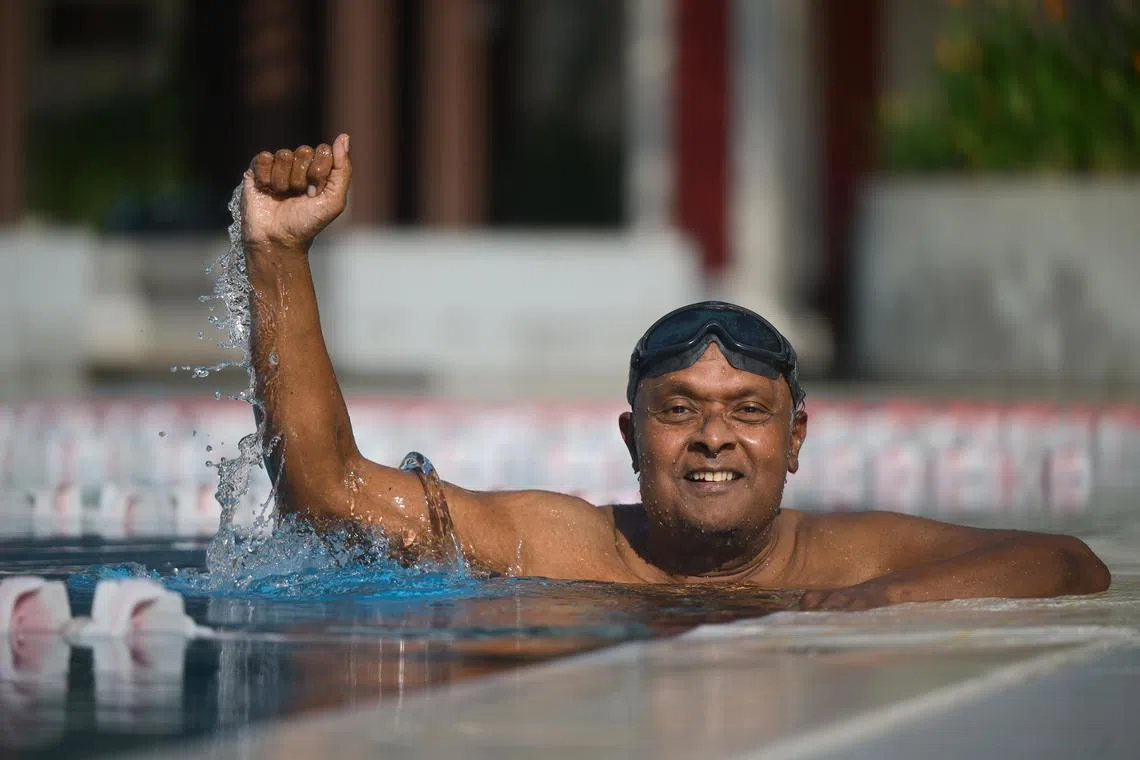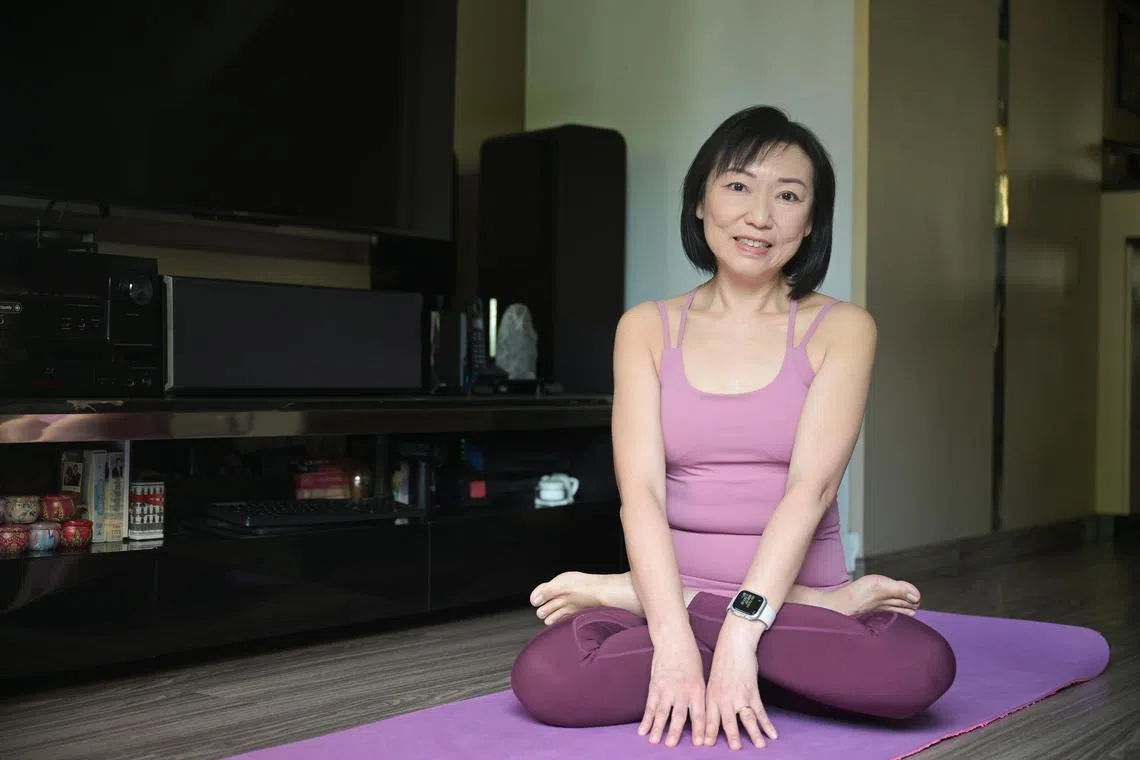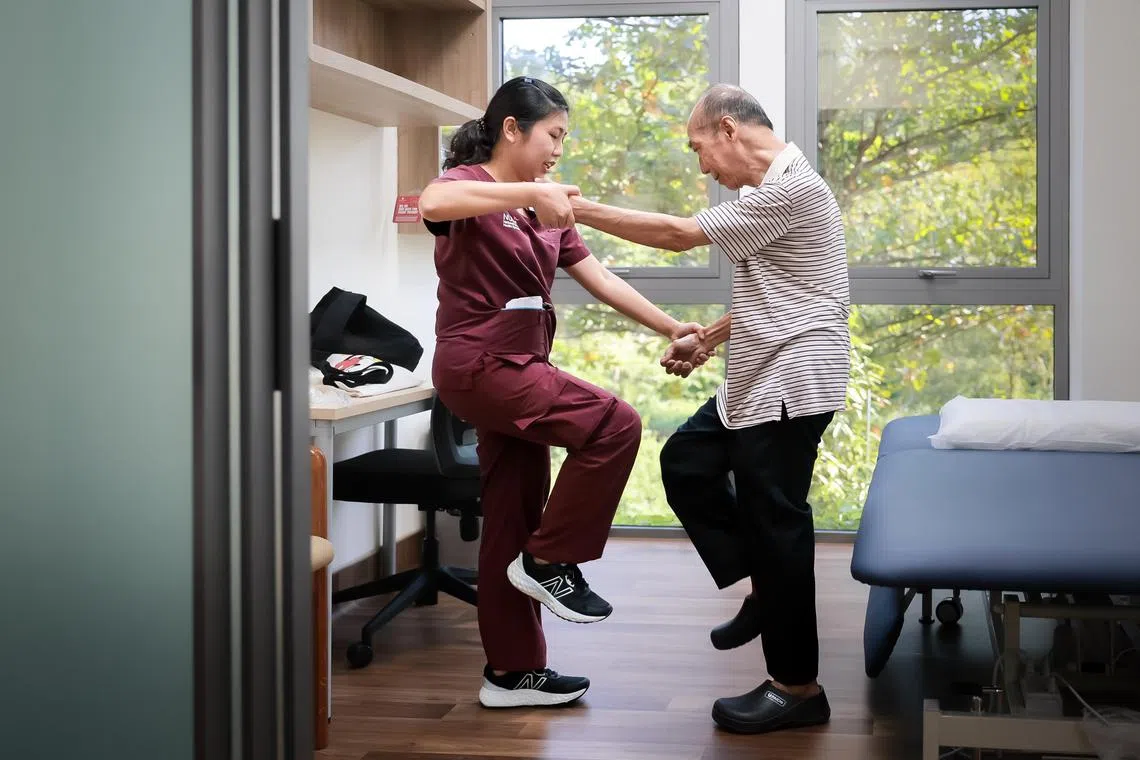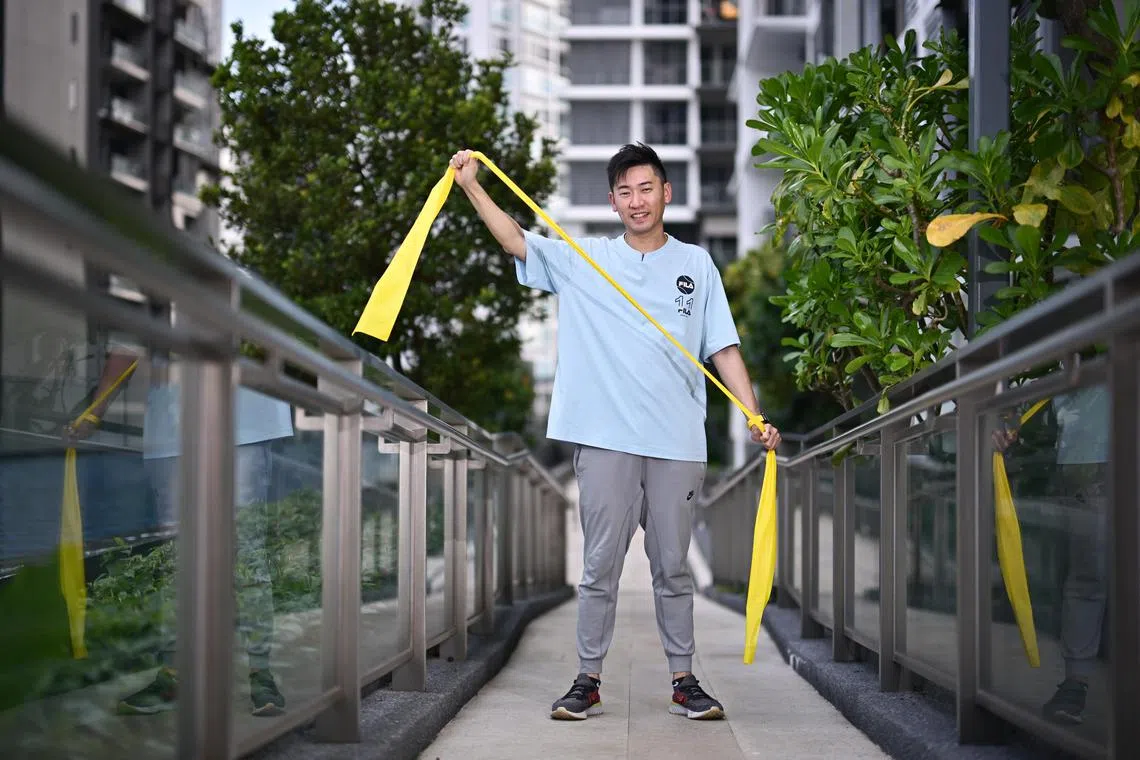Exercise as medicine: How to keep active amid chronic illness and other setbacks
Sign up now: Get ST's newsletters delivered to your inbox

Mr Jeyaraj Indra Raj developed asthma when he was younger. Now 71, he swims 30 laps five times a week at the Singapore Swimming Club.
ST PHOTO: AZMI ATHNI
Follow topic:
SINGAPORE – Mrs Dorothy Kallat used to exercise once a week until she survived breast cancer in 2009.
She now does, in a week, up to 10 hours of group fitness classes at a women-only gym near her flat in Hougang.
Exercise helped her reclaim her sense of self, as well as deal with the aches and pains of ageing.
“I want to feel healthy. I want to live longer,” says the 55-year-old, who works in banking and financial services.
Her regimen includes cardio and toning classes. She started yoga and stretching classes to help with plantar fasciitis, an intense pain in the heel.
When she began to suffer from knee aches, she worked more on strength training to help boost her leg muscles and reduce strain on the joints.
Exercise has helped alleviate all her “niggling pains”, she says.

Mrs Dorothy Kallat is a senior executive in banking. Having survived breast cancer in 2009, she now does up to 10 hours a week of group fitness classes.
ST PHOTO: AZMI ATHNI
Mrs Kallat continues to stay active even though she is back on medication for cancer, after a 2019 health screening revealed a tumour in her chest related to her 2009 illness.
Her oncologist is on board with her level of activity.
Mrs Kallat, who has two sons in their 20s, says that exercise helps her physically and mentally. “The minute I step into the studio, my energy level goes up. Exercise is a good way to relieve stress.”
Illness and physical setbacks are often a cue for people to reduce their physical activity. However, this can sometimes be counterproductive.
Doctors consider exercise a universal health prescription. Appropriate physical activity is often recommended to manage conditions such as Parkinson’s disease and asthma.
In June, the World Health Organisation (WHO) noted that moderate to vigorous physical activity can benefit people at every age and fitness level, including those with physical disabilities.
Physical activity can help prevent and manage diseases such as cardiovascular diseases, cancer and diabetes. It also reduces symptoms of depression and anxiety, enhances brain health, and can improve overall well-being.
Lack of physical activity could cost public healthcare systems US$27 billion (S$36.3 billion) a year, globally, from 2020 to 2030, WHO said, calling for countries around the world to promote physical activity.
The Singapore Physical Activity Guidelines recommend 150 minutes of moderate to vigorous activity a week for adults aged 18 to 64. But how can you exercise when coping with a chronic illness or other physical setbacks?
Here are tips from people living with asthma, cancer or Parkinson’s disease, or recovering from a stroke or accident.
Getting the right exercise prescription
Exercise can have medicinal benefits when tailored to your health conditions.
Lawyer Jeyaraj Indra Raj, who turns 71 in 2024, used to wake up gasping for breath in his 30s. The stress of work had made him develop asthma.
In addition to disturbed sleep, he could no longer play trumpet solos at church.
Doctors at St Luke’s Hospital recommended that he start swimming to improve his lung capacity. Mr Jeyaraj now clocks 30 laps five times a week at the Singapore Swimming Club and also fits in a long walk of up to 9km once a week.
This exercise regimen has enabled him to continue playing the trumpet at church and sleep through the night without worry.
He takes medication to manage diabetes and high blood pressure, but says these chronic conditions would probably be worse without his regular swims.
“Apart from the physical benefits, there are mental benefits,” says Mr Jeyaraj, who is a member of St Luke’s Hospital’s advisory council. “After exercising, I feel like I’m on cloud nine.”
Similarly, Mr Yeong Hung Peng, 74, follows an exercise routine tailored for him by physiotherapists at Alexandra Hospital (AH) in order to manage Parkinson’s disease. This condition affects muscle control, movement and balance.
Exercise improves muscle strength and alleviates joint stiffness; improves balance and flexibility; and also helps reduce symptoms such as low mood and poor sleep.

Mr Yeong Hung Peng, who has Parkinson’s disease, exercising with the help of Alexandra Hospital senior physiotherapist Pang Zhi Ling.
ST PHOTO: GAVIN FOO
Keeping active has also helped Mr Yeong overcome urinary incontinence. The need to go to the bathroom every couple of hours used to affect his sleep.
Exercises such as pelvic floor contractions helped him control his bladder. “With the exercises, I can now sleep through the night without using the toilet,” says Mr Yeong, who used to work in a printing firm before retirement.
Removing barriers to exercise
Dr Preetha Menon, consultant and deputy head of AH’s Healthy Ageing Programme, says that exercise is part of the multidisciplinary approach used to manage and treat illness and disease.
However, prescribing exercise as medicine requires working through the challenges her patients face, such as pain or disability; lack of access to information or equipment; and lack of motivation.
For example, leg-strengthening exercises can help with the pain of osteoarthritis of the knee, but she might need to prescribe pain medications as well. “You have to address chronic pain,” she says.
She also hands out exercise cards and free resistance bands or similar equipment that patients can use to exercise at home.
For those who lack motivation, she recommends group classes or suggests turning exercise into a family activity.
Do not overreach, but set small, achievable goals
Ms Pang Zhi Ling, senior physiotherapist at AH, says it is important to set realistic goals for physical activity.
Some people who have been leading sedentary lifestyles get tired walking between the rooms of their home, and should build up slowly to higher levels of activity, for example.
Mr Christopher Lek, 40, learnt this lesson the hard way. Diagnosed with acute promyelocytic leukaemia in 2022, the insurance agent spent months in hospital for chemotherapy.
Once he was discharged and moved to outpatient chemotherapy, he immediately attempted to do push-ups, which was part of his regular workout routine.
He forgot about the tube that was inserted into his upper body to receive the cancer drugs. It burst under the physical stress and he had to have it replaced in a day surgery.
When he went into remission in 2023, he returned to doing high-intensity workouts, playing tennis, cycling, golfing and going go-karting.

Insurance agent Christopher Lek, 40, exercises with a resistance band to rehabilitate his fractured left shoulder.
ST PHOTO: LIM YAOHUI
However, a go-karting accident in New Zealand in January resulted in a fractured left shoulder. He now has a metal plate with nine screws in that shoulder and finds it difficult to swing that arm.
Instead of his preferred sports, he has to focus on exercising with a resistance band to rehabilitate his shoulder.
Despite pain, stiffness and boredom, he perseveres. “There’s no enjoyment in this, but if I don’t do these exercises, I won’t have decent mobility,” he says.
Moving through setbacks
Illness can greatly reduce physical stamina, while accidents can make it physically impossible to continue your usual exercises.
Mrs Kallat’s advice is to work within the limits of your body and be kind to yourself. “Even the smallest amount of physical activity can make a difference and build a foundation for more.”
She and Mr Lek are modelling for Fashion For Cancer, a charity fashion show on Aug 31 which is raising funds for the National Cancer Centre Singapore’s Cancer Fund.
She wants others to know that despite the shadow of cancer, one can lead life like normal. “Maybe even better than normal,” she says.
In 2009, she had surgery to remove the lump in her left breast. She also went through six cycles of chemotherapy and 33 rounds of radiation therapy, which left her exhausted.
She also had to avoid group classes and crowds because the treatments had lowered her immunity to disease.
She restarted exercise gradually, beginning with short walks and stretching and building up to more intense routines.
With her 2019 relapse, she had to focus again on low-impact and lighter exercises. Yoga and pilates have helped her build up her stamina.
“Listening to my body and progressing at my own pace were key to overcoming fear and staying motivated,” she says.
Find support, have fun
Charity organisation Care Corner Singapore delivers programmes for seniors, including group fitness classes and exercise programmes to reverse physical frailty.
Ms Sharon Tang, head of its active ageing programmes, says that fear of injury and concern over age and existing health problems prevent seniors from starting to exercise.
Mass exercise can help with this, she adds. “When our seniors exercise in big groups, they feel less afraid of the consequences of falling as they are assured that there will be people around to look out for them.”
Exercise intensity is increased as seniors gain confidence. They are also taught fall prevention strategies.
Over 100 seniors who attend Care Corner Singapore programmes are training for a Sept 14 Ruckathon, where they will walk 5km carrying a weighted backpack.
Mr Christian Chao, chief executive of Care Corner Singapore, says rucking is a social fitness activity that represents the burdens that beneficiaries carry, such as physical and financial concerns.
Seniors began training twice a week from June, working on strength and mobility exercises. They are also doing training “rucks” – walking routes of 3km, 4km and 5km before the final event.
Madam Hew Lin Yin, 79, has bad knees and sometimes needs a three-day recovery period after exercising. However, the former seamstress is game for the Ruckathon.
“I want my legs to be healthy, so I need to exercise,” she says, bursting into song for part of the 3km training ruck at Punggol Waterway Park.

Madam Hew Lin Yin walking with a weighted backpack (rucking) and her walking stick during a training session organised by social service agency Care Corner Singapore at Punggol Waterway Park.
ST PHOTO: KEVIN LIM
Mr Chao hopes the training and event will help seniors like Madam Hew appreciate what they can do physically, as well as “elevate their self-esteem and motivate them to continue being active”.
Rucking in a group has also helped Mr Adrian Quah regain his fitness and confidence after he had a stroke in 2007.
The 53-year-old programme manager at Certis Cisco took almost three years to walk again. Looking for ways to get fit – he cannot run because of issues with muscular coordination – he chanced upon rucking.
He began by walking with a water bottle and now easily carries loads of 15kg on his treks.

Programme manager and stroke survivor Adrian Quah walking with a weighted backpack (rucking) during a training session organised by social service agency Care Corner Singapore at Punggol Waterway Park.
ST PHOTO: KEVIN LIM
Rucking has improved his fitness, but more important for him is the camaraderie he has found. Other ruckers look out for him on the route and they sometimes go out for meals afterwards.
“They know my condition and hang back with me,” he says. “There’s a team-building aspect.”
Info: The Care Corner Singapore Ruckathon takes place on Sept 14 (go to str.sg/kk3j str.sg/jcrv


